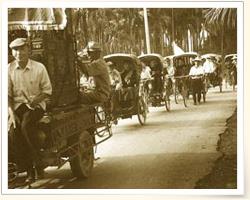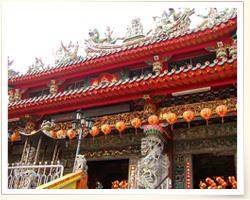|

|
Back in Qing Dynasty, Kaohsiung was a small fishing village by the sea. The Old City (Zuoying) and the New City (Fengshan) were the two prosperous areas. The Sanshan King Temple, the spiritual center of the Hakka, had appeared in both regions, evidencing the Hakka’s existence and their contribution to the development of the city. In addition, the Sanshan King Temple can be seen in present day’s Yencheng and Youchang, which also indicates that the Hakka have settled in Kaohsiung during the Qing Dynasty. It was clear that the Hakkas played a role in the development of Kaohsiung during the Qing ear, albeit it was not a dominant ethnic group at the time.
The origins of the Hakka people in Kaohsiung include the Northern Hakka from Hsinchu, Taoyuan, and Miaoli; the Central Hakka from Taichung (mostly Dongshi), and the Southern Hakka from the commonly known Liudui. The points of their arrivals varied, but the purposes were shared, to get away from poverty and establish a better life. In the early stage of the Japanese occupation, Japanese government exerted great efforts to develop Kaohsiung aiming to establish the city as their southern base. Massive labors were needed in the building of North-South railway as well as the Kaohsiung Harbor. Therefore, the Northern Hakka, living in poverty, relocated Kaohsiung en masse. They worked on menial labors as the construction workers or the tenant-peasant, in areas spanning from today's Sanmin District all the way to the Niaosong of the Kaohsiung County, which is why Sanmin District houses the largest Hakka population in Kaohsiung City.
|
 |
Along the way, the Hakka also brought the religious deities with them, which is why Yimin Temple, the spiritual symbol distinguishing Taiwan Hakka from others, has held splendid festivals in Kaohsiung. Subsequently in the mid-stage of the Japanese Occupation, the Taichung Hakka arrived with their professional skills in timber, construction and molding industries, while others prospered in the field of transportation. For instance, Kaohsiung Bus Company, one of the public transportation arms in the city, has been operated by Hakka people from Dongshi. Although Southern Hakkas began their relocation during the Japanese Occupation as well, due to the geographical advantage a much larger quantity of Southern Hakka emerged during the so-called “Ten Major Construction Projects” in the 1970s. Topped the overall Hakka population in Kaohsiung, Southern Hakkas, specifically the Liudui Hakka from Pingtung, strived to maintain the “idea of the gentleman farmer” tradition. Liudui Hakkas are known for their frugality, given little thought to fame and fortune, and worked hard to support their children’s education, which is why a substantial numbers of Liudui residents serve as teachers and even school principles in educational field, and as civil servants in public sectors.
|
|
The Prospect of Kaohsiung Hakkas
The First Urban Hakka Cultural Park in Southern Taiwan
The No. 1 and 2 Sanmin Parks are situated at the front and left side of the Kaohsiung Hakka Cultural Museum respectively. The Council for Hakka Affairs in Kaohsiung City Government plans to transform the conventional parks into an urban Hakka cultural center to preserve and demonstrate Hakka history and culture in an eco-friendly manner. The Hakka Cultural Museum will encompass the Hakka imageries, Hakka flower-themed trail, Hakka agricultural specialties, Hakka greenery, performance center and gallery. The new Hakka cultural park will be a multi-functional center for educational, cultural, industrial, and recreational activities. Furthermore, the Park represents the cultural diversity in Kaohsiung, an international metropolis where all ethnic groups as well as their cultures can co-exist peacefully and prosper.
|
|